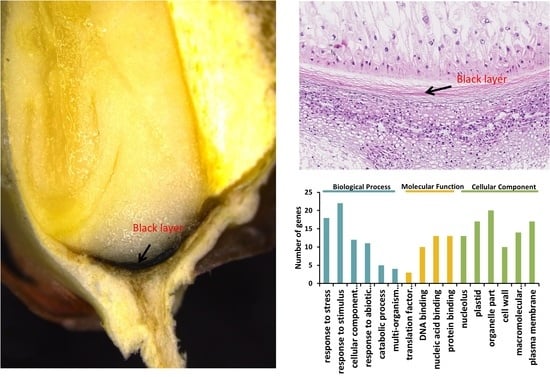Label-Free Comparative Proteomic Analysis Combined with Laser-Capture Microdissection Suggests Important Roles of Stress Responses in the Black Layer of Maize Kernels
Abstract
Share and Cite
Chen, Q.; Huang, R.; Xu, Z.; Zhang, Y.; Li, L.; Fu, J.; Wang, G.; Wang, J.; Du, X.; Gu, R. Label-Free Comparative Proteomic Analysis Combined with Laser-Capture Microdissection Suggests Important Roles of Stress Responses in the Black Layer of Maize Kernels. Int. J. Mol. Sci. 2020, 21, 1369. https://doi.org/10.3390/ijms21041369
Chen Q, Huang R, Xu Z, Zhang Y, Li L, Fu J, Wang G, Wang J, Du X, Gu R. Label-Free Comparative Proteomic Analysis Combined with Laser-Capture Microdissection Suggests Important Roles of Stress Responses in the Black Layer of Maize Kernels. International Journal of Molecular Sciences. 2020; 21(4):1369. https://doi.org/10.3390/ijms21041369
Chicago/Turabian StyleChen, Quanquan, Ran Huang, Zhenxiang Xu, Yaxin Zhang, Li Li, Junjie Fu, Guoying Wang, Jianhua Wang, Xuemei Du, and Riliang Gu. 2020. "Label-Free Comparative Proteomic Analysis Combined with Laser-Capture Microdissection Suggests Important Roles of Stress Responses in the Black Layer of Maize Kernels" International Journal of Molecular Sciences 21, no. 4: 1369. https://doi.org/10.3390/ijms21041369
APA StyleChen, Q., Huang, R., Xu, Z., Zhang, Y., Li, L., Fu, J., Wang, G., Wang, J., Du, X., & Gu, R. (2020). Label-Free Comparative Proteomic Analysis Combined with Laser-Capture Microdissection Suggests Important Roles of Stress Responses in the Black Layer of Maize Kernels. International Journal of Molecular Sciences, 21(4), 1369. https://doi.org/10.3390/ijms21041369








